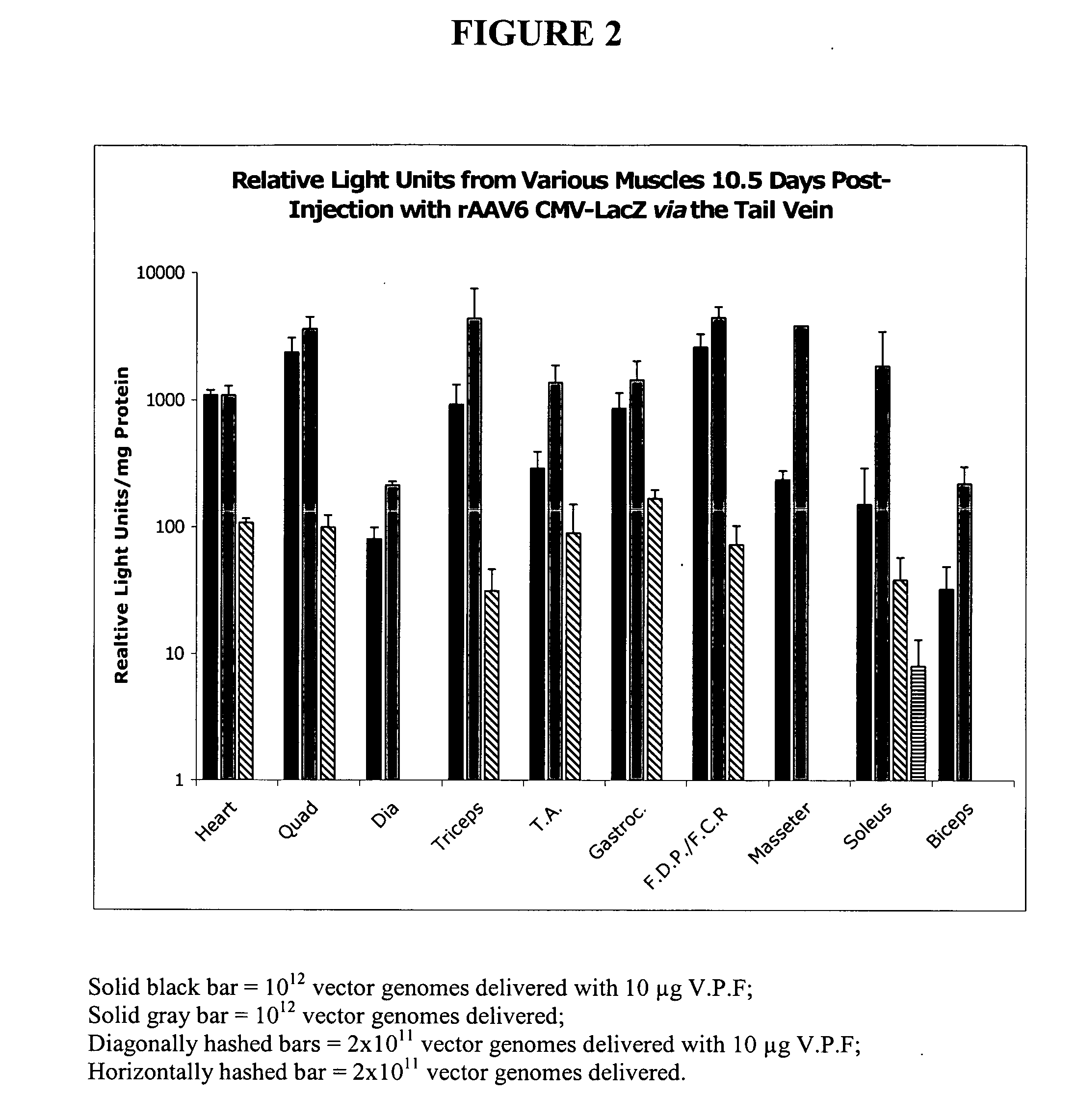Compositions and methods for systemic nucleic acid sequence delivery
- Summary
- Abstract
- Description
- Claims
- Application Information
AI Technical Summary
Benefits of technology
Problems solved by technology
Method used
Image
Examples
example 1
Adeno-Associated Viral Transduction with VEGF
[0165] This example describes systemic administration of an adeno-associated virus in combination with VEGF to animals without the use of systemic administration aids. This example also describes systemic administration of AAV6 without a vascular permeabilizing agent and without the use of systemic administration aids.
[0166] A. Materials and Methods
[0167] The following section describes the general procedure used to administer adeno-associated viral genomes and VEGF to mice.
Virus Production:
[0168] Recombinant adeno-associated virus(rAAV)vectors containing the various promoter and transgene casettes (see below) flanked by AAV serotype 2 terminal repeats were packaged using the Rep and Cap open reading frames of AAV serotype 6. To generate virus, 293D cells were transfected at a density of 3.5 to 4.0×106 cells per 10 cm diameter tissue culture dish. Transfection was carried out via calcium phosphate precipitation. Each 10 cm diameter ...
example 2
Systemic AAV Administration to a Large Mammal
[0189] This Example describes systemic AAV transduction in a dog. In this example, 4×1013 vg / kg of rAAV6 / RSV-hpAP (hpAP is human placental alkaline phosphatase; RSV is a promoter from Rous Sarcoma Virus) was injected into the jugular vein of a 2 month old beagle. Analysis of hpAP expression in the heart and diaphragm occurred at 3 weeks. The results are presented in FIG. 8, with the top two panels showing a control and the bottom two panels showing the injected canine tissue. This Example could be repeated with the addition of a vascular permeabilizing agent, such as VEGF-A.
example 3
Systemic Transduction with VEGF-A121
[0190] This Examples describes systemic transduction of mice with AAV using VEGF-A121 rather than VEGF-A165. Miice were injected with 8×1012 vg / kg of rAAV6 / CMV-lacZ±260 ug / kg VEGF-A121 via the tail vein 11 days prior to analysis of βgal activity. The results, presented in FIG. 9, show an approximately 10× increase in muscle transduction (e.g. in cardiac and skeletal muscle) by this shorter VEGF-A isoform.
EXAMLPE 4
Intravenous and Intra-Arterial Variable Timing Systemic Vector Delivery
[0191] This Example describes success with both intravenous and intra-arterial systemic viral vector administration. Eight 10 week old C57B16 mice were injected with 3.3×1013 vg / Kg (suspended in 250 microliters Ringers solution) of rAAV6-CMVlacZ via tail vein over different intervals (3 seconds, 60 seconds or 300 seconds) or via intra-femoral artery for 3 seconds. Neither injection used added VEGF (n=3 in each group). Eleven days after injection, mice were sacrific...
PUM
| Property | Measurement | Unit |
|---|---|---|
| Fraction | aaaaa | aaaaa |
| Time | aaaaa | aaaaa |
| Composition | aaaaa | aaaaa |
Abstract
Description
Claims
Application Information
 Login to View More
Login to View More - R&D
- Intellectual Property
- Life Sciences
- Materials
- Tech Scout
- Unparalleled Data Quality
- Higher Quality Content
- 60% Fewer Hallucinations
Browse by: Latest US Patents, China's latest patents, Technical Efficacy Thesaurus, Application Domain, Technology Topic, Popular Technical Reports.
© 2025 PatSnap. All rights reserved.Legal|Privacy policy|Modern Slavery Act Transparency Statement|Sitemap|About US| Contact US: help@patsnap.com



